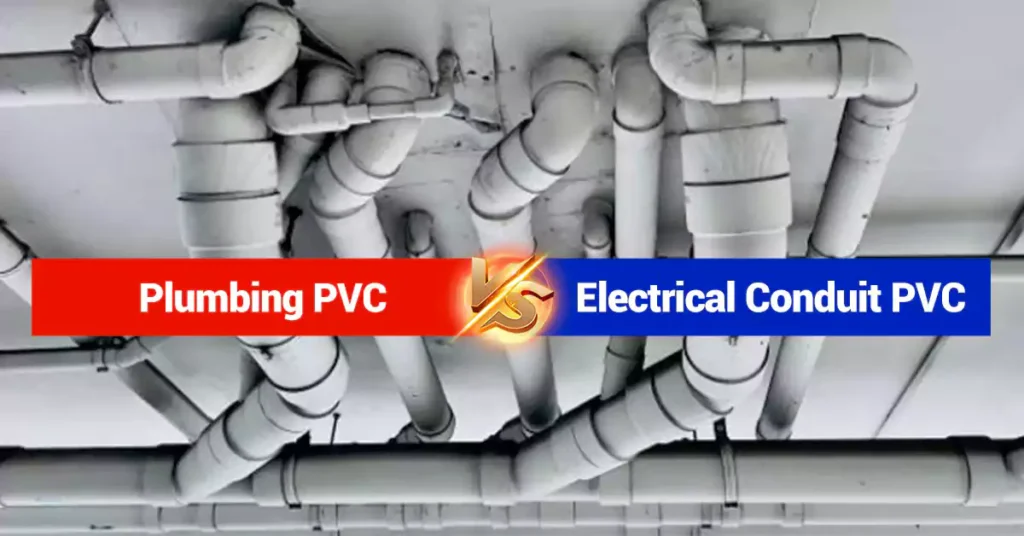
目录
在建筑和基础设施领域,PVC(聚氯乙烯)管道发挥着关键作用。由于其耐用性、价格实惠和多功能性,它们被广泛用于各种应用。然而,在 PVC 管道领域,有两种截然不同的类型经常引起用户混淆:管道 PVC 和电气导管 PVC。虽然它们乍一看可能看起来很相似,而且许多人错误地认为这两种类型的 PVC 管道可以互换,但这种误解可能会产生严重的后果。重要的是要认识到管道 PVC 和电气导管 PVC 是为完全不同的应用而设计的,具有使它们适合特定用途的不同特性。在本文中,我们将全面了解管道 PVC 和电气导管 PVC,阐明它们之间的差异,并确保用户在根据其特定需求选择合适的类型时能够做出明智的决定。
什么是管道 PVC 管?
管道 PVC,也称为 PVC-U(未增塑聚氯乙烯),是一种专门设计用于管道系统的 PVC 管。与其他应用中使用的柔性 PVC 不同,管道 PVC 坚硬耐用,能够承受管道系统中常见的高水压和温度变化。
管道 PVC 管由 PVC 树脂、稳定剂和其他添加剂组合而成,可提高其强度和耐用性。管道 PVC 中不含增塑剂,因此具有刚性和非柔性的特性,非常适合管道应用。
PVC 管在管道中有何用途?
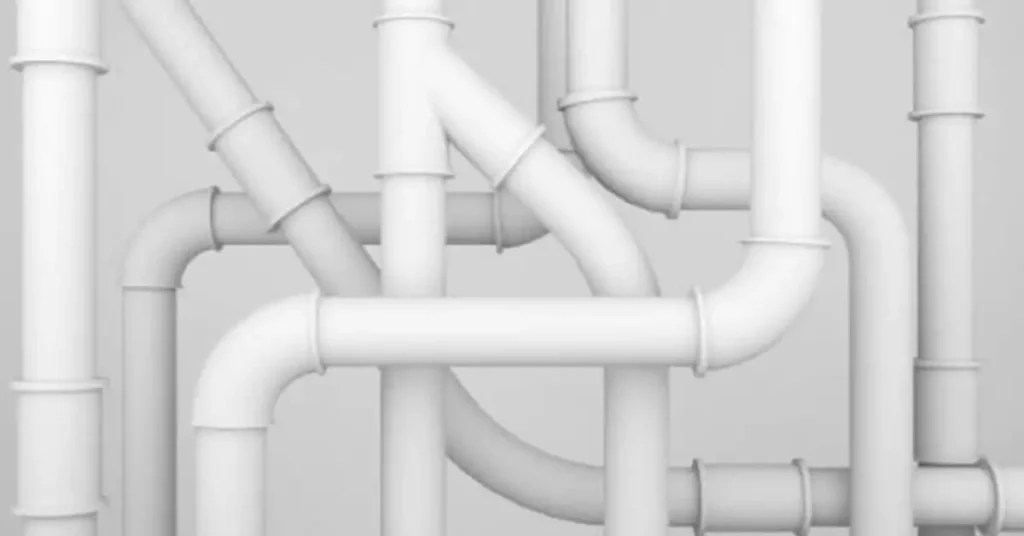
- 饮用水供应: PVC 管道广泛用于住宅、商业和工业建筑中饮用水的输送。它们适用于冷热水供应管线。PVC 管道具有耐腐蚀、耐水垢和耐化学反应等特点,是输送清洁安全饮用水的可靠选择。
- 排水和废物系统: PVC 管广泛用于建筑物的排水和废物处理系统。它们有效地将水槽、马桶、淋浴和洗衣机等固定装置中的废水和污水输送到主下水道或化粪池系统。PVC 管内部光滑,有利于废物流动并防止堵塞。
- 通风系统: PVC 管通常用于管道通风系统。通风管用于去除管道系统中的下水道气体和气味,确保适当的空气循环并防止建筑物内产生难闻的气味。PVC 管重量轻、易于安装且耐腐蚀,非常适合通风应用。
- 灌溉系统: PVC 管广泛用于农业、住宅和商业灌溉系统。它们用于将水输送到田地、花园和景观区域。PVC 管具有出色的耐化学性和抗紫外线性,非常适合经常暴露于阳光和土壤化学物质的户外应用。
- 工业管道应用: PVC 管道用于各种工业管道应用,例如化学加工厂、工厂和制造设施。它们用于在工业过程中输送流体、酸、碱和其他化学品。PVC 管道具有耐化学性,可承受各种温度,适合各种工业管道需求。
管道PVC管的特点是什么?
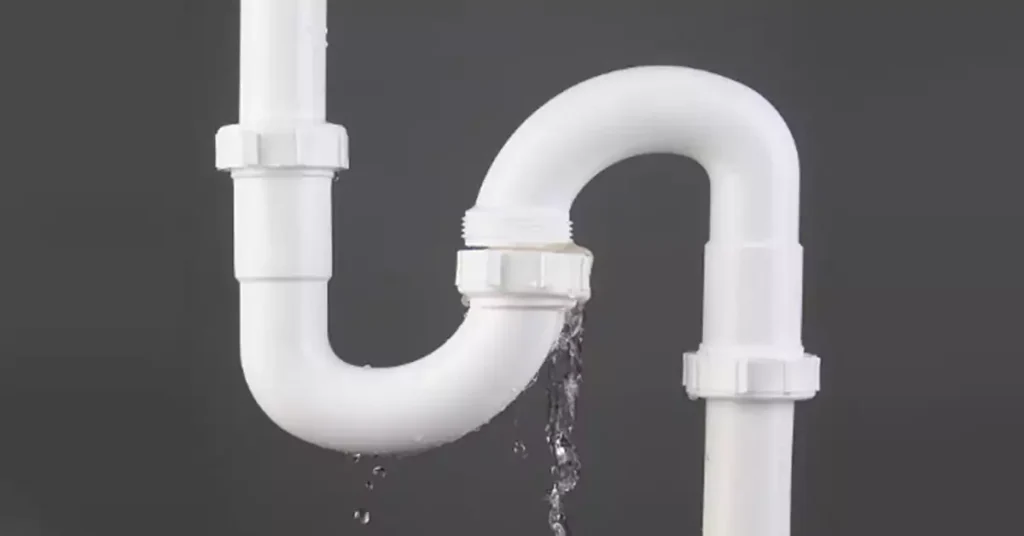
管道 PVC 管具有几个关键特性和规格,使其适用于管道应用:
- 材料: 管道 PVC 管由聚氯乙烯 (PVC) 制成,这是一种以强度、耐用性和耐化学性而闻名的热塑性材料。管道应用中使用的 PVC 管通常是刚性的,称为“计划”管。最常见的管道 PVC 管类型包括 Schedule 40 和 Schedule 80。
- 尺寸和直径: 用于管道的 PVC 管有多种尺寸和直径,可满足不同的管道需求。尺寸是标准化的,通常由其公称管道尺寸 (NPS) 或公称直径 (ND) 指定。管道 PVC 管的常见尺寸范围为 ½ 英寸至 12 英寸,对于特定应用,可提供更大的尺寸。
- 压力等级: 用于管道应用的 PVC 管具有特定的压力等级,表明其承受内部压力的能力。压力等级通常以磅/平方英寸 (psi) 表示,由管壁厚度决定。管道 PVC 管的常见压力等级包括 40 号管道的 125 psi、160 psi 和 200 psi,而 80 号管道的压力等级更高。
- 耐腐蚀性: PVC 管道具有很强的耐腐蚀性,是输送水和其他流体的管道系统的绝佳选择。与金属管道不同,PVC 管道在暴露于湿气或某些化学物质时不会生锈或腐蚀,从而确保长期耐用性并防止输送的流体受到污染。
- 光滑的内部: 管道 PVC 管道具有光滑的内表面,有利于高效流动并防止堵塞。光滑的表面可最大限度地减少摩擦和湍流,使水和其他流体能够顺畅地流过管道。此功能有助于防止堵塞并保持管道系统的整体性能。
- 耐化学性: PVC 管道对管道系统中常见的多种化学物质具有出色的耐受性。它们不受水或废水中存在的大多数酸、碱、盐和其他化学物质的影响。这种耐化学性可确保管道的使用寿命,并最大限度地降低因接触化学物质而导致管道性能下降或损坏的风险。
- 安装简便: PVC 管重量轻,易于搬运和安装。它们可以使用各种方法进行切割、连接和连接,例如溶剂粘合、螺纹配件或机械联轴器。PVC 管通常具有标准化插座或喇叭口,可方便连接,而无需特殊工具或复杂技术。
PVC 管道的优点和缺点
PVC管道的优点:
耐用性: 管道 PVC 管非常耐用,并且耐生锈、腐蚀和化学降解,确保较长的使用寿命。
负担能力: 与其他管道材料相比,PVC 管道具有成本效益,因此成为住宅和商业管道项目的热门选择。
轻的: 管道 PVC 管道重量轻,易于搬运和安装,从而减少了人工和安装成本。
PVC管道的缺点:
限制温度范围: 虽然管道 PVC 管可以承受各种温度,但与其他管道材料(例如铜或 PEX)相比,它们具有温度限制。
易受紫外线辐射: 管道 PVC 管在长时间暴露于阳光或紫外线辐射下时容易老化。因此,在户外应用中,应对其进行适当保护或埋入地下。
管道 PVC 安装技巧
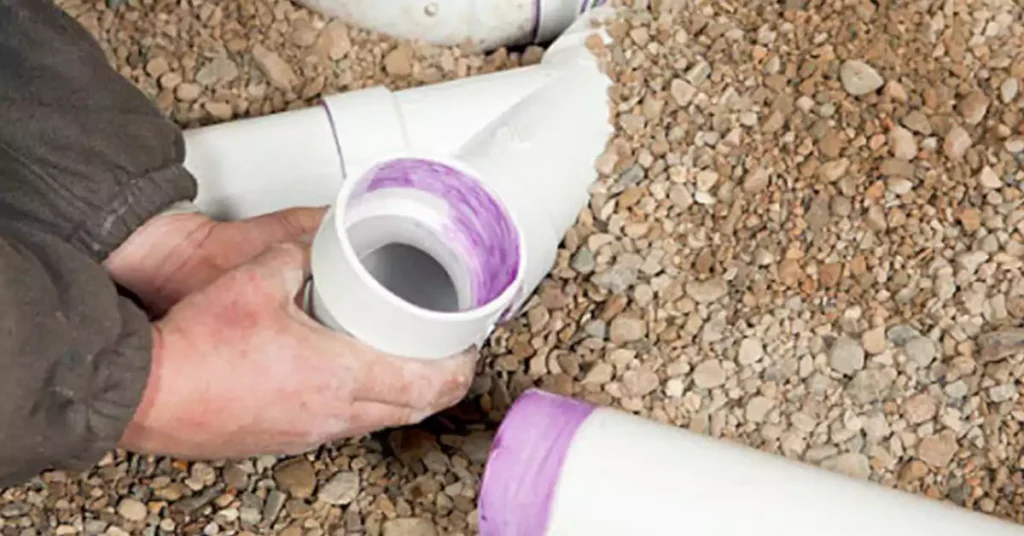
正确的安装技术对于 PVC 管道的有效性能至关重要。一些关键考虑因素包括:
切割和连接: 管道 PVC 管可以用 PVC 管切割机或钢锯轻松切割成所需长度。它们通常使用溶剂胶连接,从而形成牢固且防漏的连接。
支持与协调: 安装过程中,适当的支撑和对齐至关重要,以确保管道牢固且正确对齐。应使用足够的支撑,例如管道吊架或支架,以防止下垂或错位。
膨胀和收缩: 管道 PVC 管具有一定程度的热膨胀和收缩。应适当考虑这些运动,以防止管道受压和潜在泄漏。
管道 PVC 规范合规性和法规
管道 PVC 管道必须遵守特定的建筑规范和法规,以确保安全和合规。这些规范可能因地区或管辖区而异,但通常涵盖管道尺寸、安装方法和材料标准等方面。
一些常见的标准包括:
ASTM D1785: 这是 40、80 和 120 号 PVC 塑料管的标准规范。它涵盖了用于压力应用(包括供水和配水)的 PVC 管的尺寸、性能和材料要求。
NSF/ANSI 14: 本标准规定了饮用水系统中使用的塑料管道和配件的要求。它涵盖了符合供水系统使用的特定健康和性能要求的 PVC 管道和配件。
NSF/ANSI 61: 该标准规定了饮用水系统组件(包括 PVC 管道)所用材料的化学浸出和健康影响要求。它确保 PVC 管道符合必要的水质和安全标准。
CSA B181.2: 该标准名为“热塑性排水、废水和通风管道及管件”,规定了加拿大排水、废水和通风 (DWV) 系统中使用的热塑性管道和管件的要求。它涵盖了 PVC 管道和管件以及其他热塑性材料,并制定了尺寸、材料、性能和测试方法的规范。
CSA B137.3: 该标准名为“压力应用用硬质聚氯乙烯 (PVC) 管”,规定了加拿大压力应用中使用的硬质 PVC 管的要求。它涵盖了用于配水、灌溉系统和其他压力应用的 PVC 管,并包括尺寸、材料、性能、测试和标记的规定。
国际管道规范 (IPC): IPC 是美国许多州和市政当局采用的示范规范。它规定了管道系统的最低要求,包括在各种管道应用中使用经批准的材料(例如 PVC 管)。
什么是电气导管 PVC?
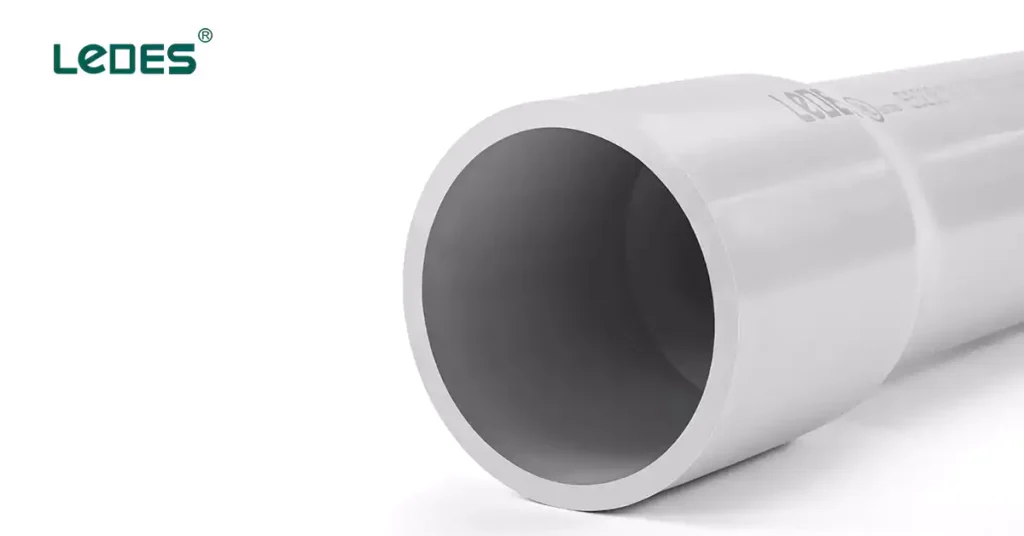
PVC 电气导管是一种专为电气安装而设计的 PVC 管。它可作为电线的保护壳,保护电线免受物理损坏、潮湿和其他环境因素的影响。PVC 电线管不导电,这意味着它不导电,从而确保电气系统的安全。
PVC电管的用途有哪些?
PVC 电气导管广泛应用于各种电气应用,一些常见的应用包括:
住宅布线: PVC 电线管通常用于住宅建筑,以保护和布线。它可用于明装和暗装,例如穿过墙壁、天花板和地板的电线。
商业和工业建筑: PVC 导管在商业和工业环境中得到广泛应用。它用于办公室、零售空间、工厂、仓库和其他需要电气系统的建筑中的布线。
户外设施: PVC 导管适用于户外应用,电线需要保护免受潮湿、阳光和其他环境因素的影响。它通常用于将电线连接到户外照明、泵、空调机组和其他户外设备。
地下布线: PVC 导管通常用于地下电气安装,以保护线路免受土壤、湿气和外部损坏。它直接埋在地下,可用于地下电气服务入口、住宅地下馈线和户外照明系统等应用。
数据和通信布线: PVC 导管用于布线数据和通信电缆,例如以太网、电话和同轴电缆。它为这些电缆提供保护和组织,确保高效可靠的数据传输。
太阳能: 随着太阳能发电设施的日益普及,PVC 导管经常用于容纳和保护太阳能电池板系统中的电线。它有助于将电线从太阳能电池板布线到逆变器和其他组件。
PVC电工套管的特点是什么
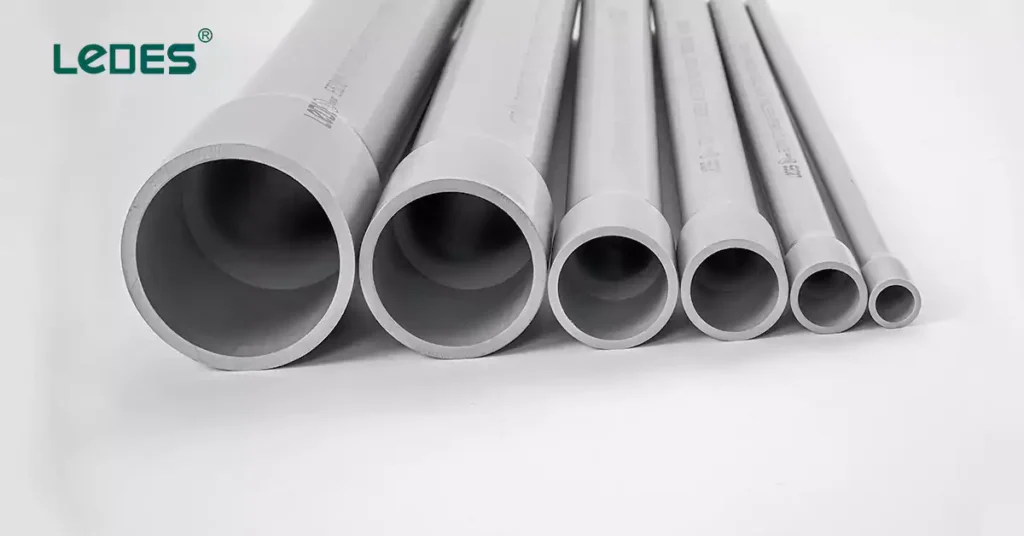
PVC 电线管具有多种关键特性,使其成为保护和布线各种应用中电线的首选。以下是 PVC 电线管的一些主要特性:
耐用且耐冲击: PVC 导管以其耐用性和抗冲击能力而闻名。它为电线提供出色的保护,防止意外碰撞、撞击或磨损等物理损坏。
耐腐蚀: PVC 具有抗腐蚀的特性,适合室内和室外安装。它能够抵御潮湿、化学物质和其他腐蚀性元素,确保长期性能和可靠性。
非导电: PVC 是一种非导电材料,也就是说它不导电。这一特性使 PVC 导管成为安全布线的绝佳选择,可降低触电或短路风险。
抗紫外线: PVC 导管可制造成具有抗紫外线特性,使其能够承受长时间暴露在阳光下而不会降解或变脆。这一特性使其适合需要防紫外线辐射的户外应用。
防火: 提供耐火 PVC 电气导管变体,在需要满足消防规范或规定的应用中提供额外的防火保护。
重量轻且易于安装: 与其他导管材料相比,PVC 导管重量较轻,因此更易于搬运和安装。PVC 导管重量轻,可减少安装时间和精力,因此是专业人士和 DIY 爱好者的首选。
经济高效: PVC 导管通常比其他导管材料(如金属导管)更实惠。其成本效益使其成为各种电气安装的理想选择,有助于降低项目成本。
PVC 导管安装技巧
正确的安装技术对于电气导管 PVC 的有效性能至关重要。一些关键考虑因素包括:
规划布局: 安装前,应仔细规划和布局,确定电气导管 PVC 的最佳布线路线。考虑诸如可达性、未来扩展以及项目的具体电气要求等因素。
适当的弯曲: 必要时,可以使用加热或专用 PVC 导管弯曲工具弯曲电气导管 PVC。务必遵循制造商的指导方针并保持最小弯曲半径,以防止损坏导管。
安全紧固: 应定期使用适当的带子、夹子或吊架将电气导管 PVC 牢固固定,以防止下垂并确保稳定性。
PVC 电气导管规范合规性和规定
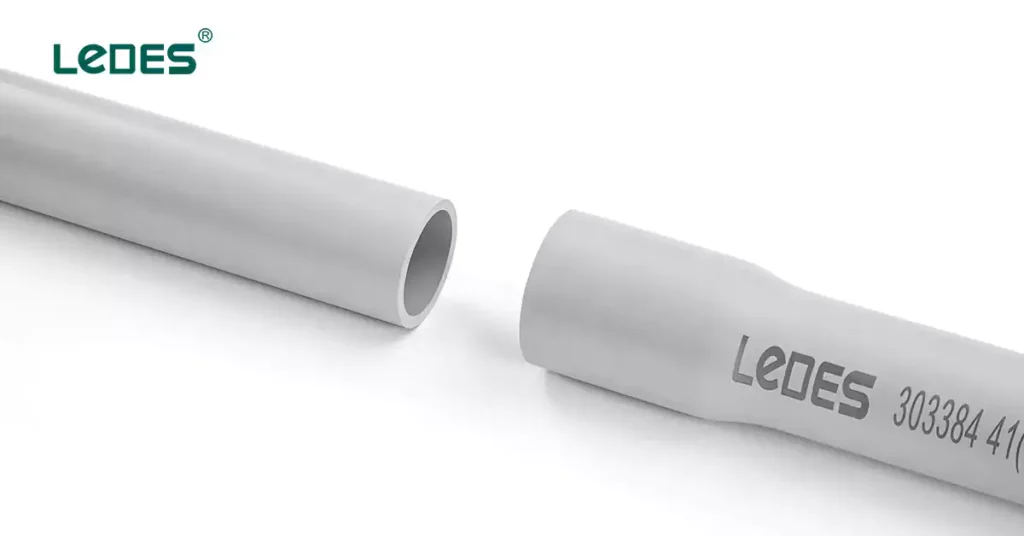
PVC 电气导管安装必须遵守特定的电气规范和规定,以确保安全和合规。一些常见的遵循标准包括:
ASTM D1784: 此 ASTM 标准规定了制造 PVC 电气导管所用 PVC 树脂的要求。它确保导管生产中使用的 PVC 材料符合特定的质量和性能标准。
UL651: UL651 是美国保险商实验室 (UL) 制定的一项标准,涵盖电气安装用的 PVC 导管和配件。它规定了 PVC 导管的物理特性、性能和测试要求,以确保其适用于各种电气应用。
CSA C22.2 第 211.2 号: 此 CSA(加拿大标准协会)标准适用于加拿大电气设备中使用的硬质 PVC 导管、配件和附件。它规定了 PVC 导管的尺寸、材料、性能和测试要求,以确保其安全性并符合加拿大电气标准。
NEMA TC-2: 美国电气制造商协会 (NEMA) TC-2 标准涵盖了美国电气应用中使用的 PVC 导管。该标准规定了 PVC 导管的尺寸、性能和测试要求,以确保其适用于电气安装。
NEC(国家电气规范): NEC 是美国广泛采用的电气规范,为安全电气安装提供指导。它包括导管安装(包括 PVC 导管)的要求,涉及尺寸、布线、接地和其他安全考虑。遵守 NEC 对于确保安全且符合规范的 PVC 导管安装至关重要。
管道 PVC 与电气导管 PVC 之间的区别
说到 PVC 管,重要的是要注意管道 PVC 和电线管 PVC 的不同特性和用途。虽然它们看起来相似,但它们具有不同的功能,并具有使其适合各自应用的特定功能。
尺寸和规格:
管道 PVC 管有多种尺寸可供选择,通常直径为 ½ 英寸至 24 英寸,也有其他尺寸可供选择。这些尺寸对应于供水管线、排水管线和通风系统的标准管道要求。另一方面,电线管 PVC 管的直径通常较小,通常直径为 ½ 英寸至 6 英寸。电线管 PVC 管的尺寸取决于它们要封装的电线数量和尺寸。
● 壁厚:
与电线管 PVC 管相比,管道 PVC 管的管壁通常更厚。管道 PVC 管的管壁厚度增加是为了承受管道系统中常见的高水压。另一方面,电线管 PVC 管的管壁较薄,因为它们的主要用途是保护电线,而不是承受压力。
以下是 40 号和 80 号 PVC 管与 40 号和 80 号硬质 PVC 导管的一些尺寸比较(部分尺寸):
| 项目/管道 | 40 号 PVC 管(英寸) | Sch. 40 PVC Electrical Conduit (Inches) | ||||
| Sizes | O.D | Ave. I.D | Min. Wall | Ave. O.D | Min Ave. I.D | Min. Wall |
| 1/2” | 0.840 | 0.602 | 0.109 | 0.840 | 0.578 | 0.109 |
| 3/4” | 1.050 | 0.804 | 0.113 | 1.050 | 0.780 | 0.113 |
| 1” | 1.315 | 1.029 | 0.133 | 1.315 | 1.004 | 0.133 |
| 1-1/4” | 1.660 | 1.360 | 0.140 | 1.660 | 1.335 | 0.140 |
| 1-1/2” | 1.900 | 1.590 | 0.145 | 1.900 | 1.564 | 0.145 |
| 2” | 2.375 | 2.047 | 0.154 | 2.375 | 2.021 | 0.154 |
| 2-1/2” | 2.875 | 2.445 | 0.203 | 2.875 | 2.414 | 0.203 |
| 3” | 3.500 | 3.042 | 0.216 | 3.500 | 3.008 | 0.216 |
| 3-1/2” | 4.000 | 3.521 | 0.226 | 4.000 | 3.486 | 0.226 |
| 4” | 4.500 | 3.998 | 0.237 | 4.500 | 3.961 | 0.237 |
| 5” | 5.563 | 5.016 | 0.258 | 5.563 | 4.975 | 0.258 |
| 6” | 6.625 | 6.031 | 0.280 | 6.625 | 5.986 | 0.280 |
| 8” | 8.625 | 7.942 | 0.322 | — | — | — |
| 10” | 10.750 | 9.976 | 0.365 | — | — | — |
| 12” | 12.750 | 11.889 | 0.406 | — | — | — |
项目/管道 | Sch. 80 PVC Pipe (Inches) | Sch. 80 PVC Electrical Conduit (Inches) | ||||
Sizes | O.D | Ave. I.D | Min. Wall | Ave. O.D | Min Ave. I.D | Min. Wall |
1/2” | 0.840 | 0.526 | 0.147 | 0.840 | 0.502 | 0.147 |
3/4” | 1.050 | 0.722 | 0.154 | 1.050 | 0.698 | 0.154 |
1” | 1.315 | 0.936 | 0.179 | 1.315 | 0.910 | 0.179 |
1-1/4” | 1.660 | 1.255 | 0.191 | 1.660 | 1.227 | 0.191 |
1-1/2” | 1.900 | 1.476 | 0.200 | 1.900 | 1.446 | 0.200 |
2” | 2.375 | 1.913 | 0.218 | 2.375 | 1.881 | 0.218 |
2-1/2” | 2.875 | 2.290 | 0.276 | 2.875 | 2.250 | 0.276 |
3” | 3.500 | 2.864 | 0.300 | 3.500 | 2.820 | 0.300 |
3-1/2” | 4.000 | 3.326 | 0.318 | 4.000 | 3.280 | 0.318 |
4” | 4.500 | 3.786 | 0.337 | 4.500 | 3.737 | 0.337 |
5” | 5.563 | 4.768 | 0.375 | 5.563 | 4.713 | 0.375 |
6” | 6.625 | 5.709 | 0.432 | 6.625 | 5.646 | 0.432 |
8” | 8.625 | 7.565 | 0.500 | — | — | — |
10” | 10.750 | 9.493 | 0.593 | — | — | — |
12” | 12.750 | 11.294 | 0.687 | — | — | — |
压力等级:
Plumbing PVC pipes are designed with specific pressure ratings, such as Schedule 40 or Schedule 80, indicating their ability to handle different water pressures. These pressure ratings are essential to ensure the integrity and safety of the plumbing system. In contrast, electrical conduit PVC pipes are not pressure-rated since they are not intended to contain fluids under pressure.
Here are the pressure requirements for two most widely used plumbing PVC pipe, Schedule 40 and Schedule 80 PVC Pipe:
Pressure Rating (psi) | ||
Norminal Size | Schedule 40 PVC Pipe | Schedule 80 PVC Pipe |
1/2” | 600 | 850 |
3/4” | 480 | 690 |
1” | 450 | 630 |
1-1/4” | 370 | 520 |
1-1/2” | 330 | 470 |
2” | 280 | 400 |
2-1/2” | 300 | 420 |
3” | 260 | 370 |
3-1/2” | 240 | 350 |
4” | 220 | 320 |
5” | 190 | 290 |
6” | 180 | 280 |
8” | 160 | 250 |
10” | 140 | 230 |
12” | 130 | 230 |
Waterproof:
Plumbing PVC pipes are designed to be watertight since their primary function is to transport water. They are constructed to prevent leaks and maintain the flow of water within the plumbing system. On the other hand, electrical conduit PVC pipes do not require the same level of waterproofing since their primary purpose is to protect electrical wiring from physical damage and environmental factors.
颜色:
One obvious difference between plumbing PVC pipe and PVC electrical conduit is their colors. Plumbing PVC pipe is usually in white color, but Schedule 80 PVC pipe is usually dark gray. On the other hand, PVC electrical conduit is usually gray, they are light gray not as Schedule 80 PVC pipe’s dark gray. Manufacturers could add different chemicals to create different colors of pipe and conduit.
配件:
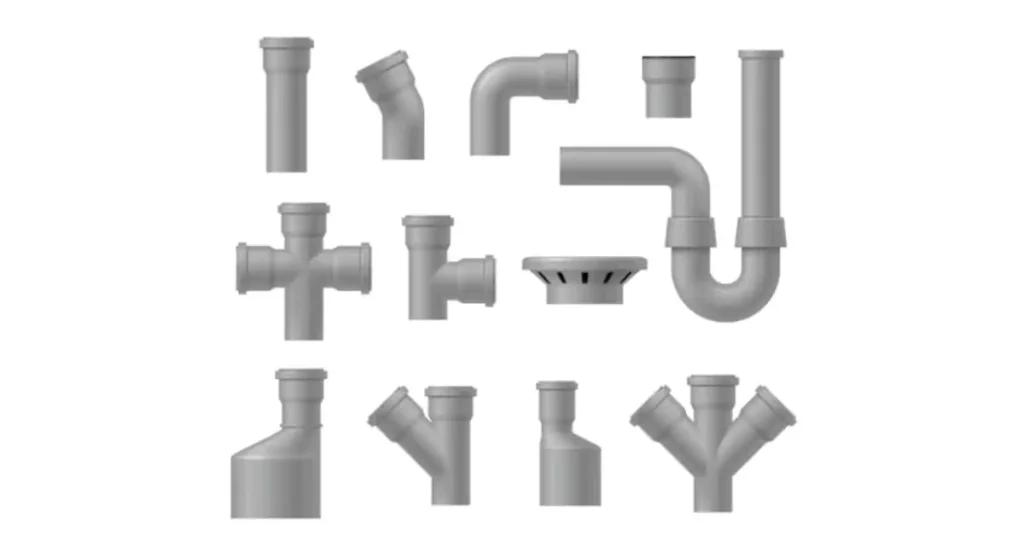
Plumbing PVC and electrical conduit PVC pipes use different types of fittings. Plumbing PVC fittings are designed for water-tight connections and include options such as couplings, elbows, tees, and valves. Electrical conduit PVC fittings, on the other hand, are specifically designed for electrical installations and include connectors, couplings, conduit bodies, and boxes that allow for the proper routing and connection of electrical wires.
应用:
Plumbing PVC pipes are intended for use in plumbing systems, such as water supply lines, drain lines, and ventilation systems in residential, commercial, and industrial buildings. They are compatible with various plumbing fixtures and appliances. Electrical conduit PVC pipes, on the other hand, are used to protect electrical wiring in applications such as residential electrical systems, commercial buildings, and outdoor installations. They are compatible with electrical wires, cables, and electrical boxes.
Can You use Plumbing PVC for Electrical Conduit?
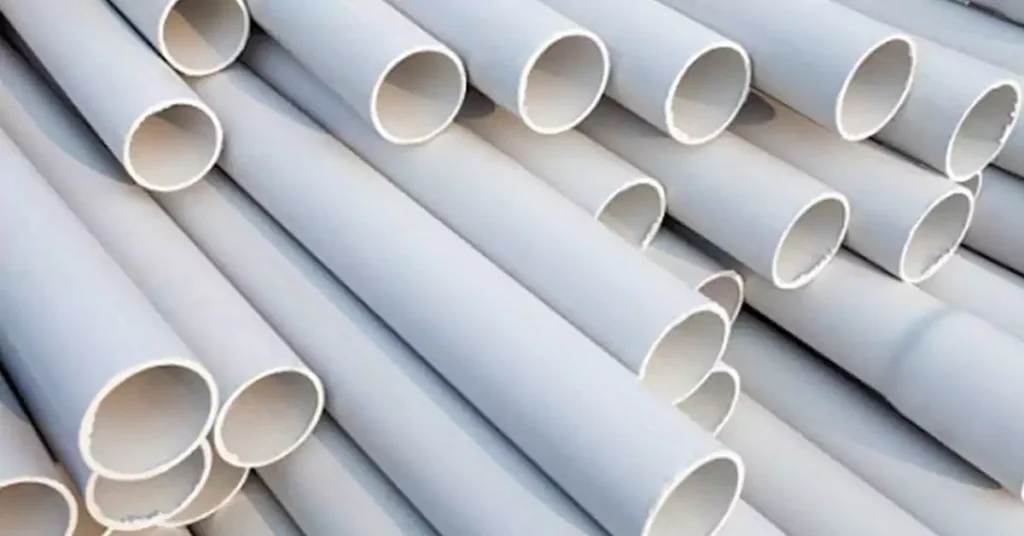
Misusing plumbing PVC or electrical conduit PVC can lead to various consequences, it is essential to understand the potential risks associated with using these types of PVC pipes inappropriately to avoid costly and dangerous outcomes.
Water Pressure Issues:
One of the significant consequences of misusing plumbing PVC or electrical conduit PVC is water pressure problems. Plumbing PVC pipes are specifically designed to handle the high water pressures commonly found in plumbing systems. They have thicker walls and higher pressure ratings to ensure the integrity and functionality of the system. If electrical conduit PVC pipes, which have thinner walls and lack pressure ratings, are used in plumbing applications, they may fail under the sustained water pressure. This can result in burst pipes, leaks, and water damage to the surrounding areas.
Leaks and Water Damage:
Misusing plumbing PVC or electrical conduit PVC can result in leaks and water damage. Plumbing PVC pipes are engineered to be watertight, ensuring the proper containment and flow of water within the plumbing system. In contrast, electrical conduit PVC pipes are not designed with the same level of waterproofing. Using electrical conduit PVC pipes in plumbing applications can lead to leaks due to the lack of proper seals and connections. Prolonged exposure to water leaks can cause structural damage, mold growth, and costly repairs.
Safety Hazards:
Using plumbing PVC in place of electrical conduit PVC or vice versa can create significant safety hazards. Plumbing PVC pipes are not designed to withstand electrical currents and may pose a risk of electrical shock or fire when used for electrical wiring. Similarly, electrical conduit PVC pipes are not intended to handle the high water pressures typically found in plumbing systems. Using electrical conduit PVC for plumbing applications can result in burst pipes, water leaks, and property damage.
Increased Maintenance and Repair Costs:
Misusing PVC pipes can significantly increase maintenance and repair costs in the long run. Water pressure issues, reduced flow, leaks, and water damage often require extensive repairs and replacements. Fixing or replacing incorrectly installed or incompatible PVC pipes can involve significant expenses, including labor costs, material costs, and potential damage to other components of the plumbing system.
Code Violations:
Using plumbing PVC or electrical conduit PVC pipes incorrectly can result in code violations. Building codes and regulations specify the appropriate materials and installation methods for plumbing and electrical systems. Deviating from these guidelines and using the wrong type of PVC pipe can lead to non-compliance with code requirements. Code violations may result in penalties, the need for costly corrections, or difficulties in obtaining insurance coverage.
To avoid water pressure problems and associated consequences, it is crucial to use plumbing PVC pipes specifically designed for plumbing applications. Adhering to plumbing codes and regulations, consulting with professionals, and ensuring proper installation will help maintain the integrity of the plumbing system, prevent water pressure issues, and minimize the risk of damage or safety hazards.
Is PVC Pipe Safe for Drinking Water?
PVC (Polyvinyl Chloride) pipes are commonly used for various applications, including plumbing systems. When it comes to using PVC pipes for drinking water, it is important to consider certain factors to ensure their safety and suitability for this purpose.
PVC pipes manufactured specifically for plumbing applications are typically safe for transporting drinking water. However, it is vital to use PVC pipes that are approved for potable (drinking) water by regulatory authorities, such as the National Sanitation Foundation (NSF) in the United States. These certified PVC pipes undergo rigorous testing to ensure they meet specific safety and performance standards.
However, it is important to note that the safety of PVC pipes for drinking water can be influenced by various factors, including the quality of the water supply, temperature, and the presence of certain chemicals. PVC pipes may not be suitable for conveying extremely hot water or water containing high levels of certain chemicals or solvents. In such cases, alternative materials like CPVC (Chlorinated Polyvinyl Chloride) or PEX (Cross-linked Polyethylene) pipes may be more appropriate.
When using PVC pipes for drinking water, it is crucial to follow proper installation practices, including using approved fittings, ensuring adequate support, and avoiding excessive bending or stress on the pipes. Regular maintenance and periodic inspections are also important to detect any potential issues, such as leaks or degradation, that could affect the water quality.
结论
In conclusion, understanding the differences between plumbing PVC and electrical conduit PVC is essential for selecting the appropriate type of PVC pipe for specific applications. Throughout this article, we have discussed the key distinctions between these two types of PVC pipes in terms of sizes and dimensions, pressure ratings, waterproofing, color, design and construction, as well as fittings.
Using the correct type of PVC pipe for a specific application is of utmost importance. Misusing plumbing PVC or electrical conduit PVC can result in many safety problems and increase maintenance costs. When choosing the right pipe, adhering to building codes and regulations, consulting with professionals, and following manufacturers’ guidelines to ensure the proper selection and installation of plumbing PVC or electrical conduit PVC pipes.
如有任何问题, 请随时联系我们。



